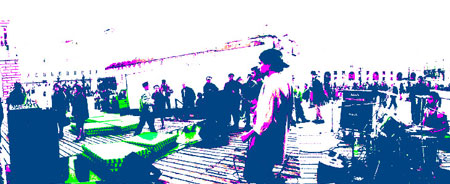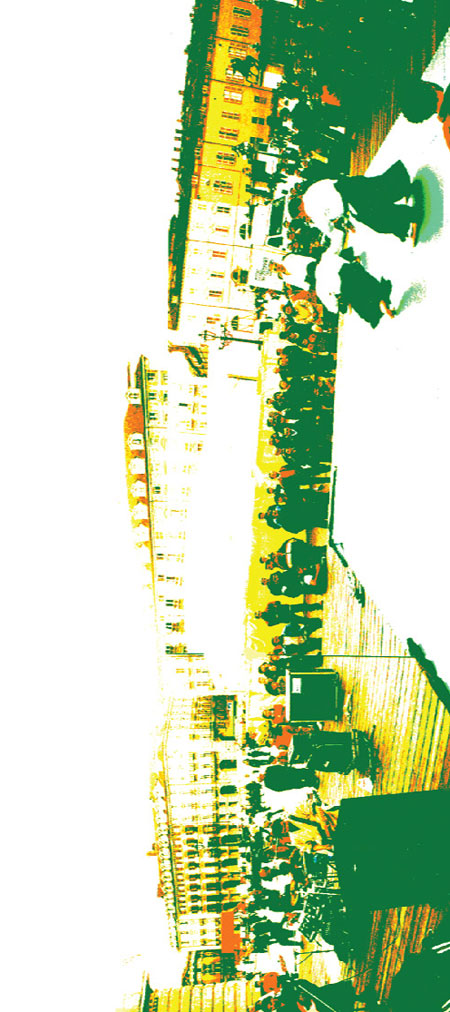joko handia turinen totoetotikui
I aiora Sortzen ari den Europa berri honetan, garai estetiko bat bizitzen ari gara, artea, diseinua eta publizitatea merkatuan uztarturik, Bilbon eta Donostian gertatu bezala (Guggenheim... eta Kursaal direla eta), artearekin egin dute apostua hiri askok. Horien artean eskertzekoa da Turinek arte gaztearekin apostua egin izana, gazteontzat Europa zaharrean toki bat hutzita behingoz. Noski gazteok ere dirua erakartzen dugula ikusi baitute, baita hiria gaztetu eta izena zabaldu ere haien Europa honetan.
Benetan ziutate estetikoa Torino, bertako karriketatik pasiatzen bazara ikus ditzakezu plaza zahar boteretsuak eskenatoki bihurtuta eta bertako biztanleak kalitatezko bestuarioa haien soineetan, superprodukzio bat bailitzan, Quo Vadis eta Pretty Woman-en artekoa. Bienala ezta lehiaketa, aurretik eginiko aukeraketa baten ondorioz eginiko erakusketa, ospakizuna baizik. Michelangelo Pistoletto-ren gidaritza artistikoa eta hainbat artistek diru publiko zein pribatuaren laguntzaz, oso azpiegitura ona lortu dute. Hiriaren zentruan eskultura (publiko zein itxia), pintura, ingenieritza, diseinua, happenning , performance, dantza, musika, interbentzio eta abar ikusi daiteke hile osoan zehar.
Euskal Herritik bi aukeratu izan ziren, Ainara Etxeberria Zubiaurre eta Jose Garcia Carrera. Ainararen instalazioa panel zuri bat da, urte osoan zehar berari mugikorrera bidalitako mezu guztiak bertan itxatxita, pertsona bakoitza kolore batetan eta autorretrato izenarekin.
Jose Garcia-k Transtoday proiektua aurkeztu zuen. Asturiarra baina Leioako arte ederretako ikaslea da, eta bere taldea hiru aikidoka (David, Kikutxo eta Juanpa), bi skater (Quique eta Cesar), eta hiru musikarik (Borja, Jose eta Kepa) osatzen genuen. Kalean egindako aktuazio bat zen, inprobisatutako musika, aikido eta skate erakusketak elkartuz, energia eta egitearen aldeko ikuskizun bat sortu nahian.
Artearen merkatuan hanka sartzeko gogoak dituzten mundu osoko gazteen obrak ikus daitezke, egungo zein betiko baliabideak erabiliz, aipagarria hainbat eta hainbat artelanetan pantaila bat erabiltzea, Ikusentzute euskarri standarra, familiarra; alde batetik eskertzekoa honek eremua zehazten laguntzen gaituelako, halako arte erakusketa haundietan hainbeste eskultura eta instalazio elkarren ondoan egoteak ez baitu batere erreztasunik ematen hura zeureganatzen. Zarata protagonista bihurtzen da normalean.
Gazteok artea zertarako erabiltzen dugun garrantzitsua da, badaude artea helburu bezela aurkezten duten gutti batzu (arteari buruz hitzegiten dutenak), eta instrumentu bezala erabiltzen dutenak, norberaren munduarekiko heritzia plazaratzeko. Bertako artista askok, bienala salaketa sozial eta politikoak egiteko erabili dute, Genovan hildako Carlo Giulianni-ren mihise bat eta Berlusconiren erregimenaren kontrako pankarta batzu barne (izan omen dituzte hagatik denutzia batzuen mehatxuak ere), baina era berean arte merkatua ez ote da disidentziaren estetika erabiltzen ari?
Honen inguruan aritzeko zera kontatu nahi nuke; Piazza Castello enparantzan badago 10x20mko panel arroxa izugarri bat; oso presentzia liraina, goxoa eta era berean boteretsua zuen arroxa eremu horrek jauregi zaharren aurrekaldea estaliz; gau batetan pinturaz eta kartelez josita ikusi genuen, bere edertasuna zikinduz, arroxa sakon eta zerutiar hura lurrera ekarriz; artelanaren parte zela iruditu zitzaigun, noski, gaur egun arteak horrelako aukerak onartuta baititu, baina ez, abiadura haundiko trenaren aurkako akzio bat izan zen, oso artistikoa nire ustetan.
Zeinek zein erabiltzen duen erantzun al daiteke hartu eman hau semiologi joko bat bihurtu gabe? Bienalaren leloak ondo eusten dio galdera honi: "We need to talk its a big social game".
Benetan ziutate estetikoa Torino, bertako karriketatik pasiatzen bazara ikus ditzakezu plaza zahar boteretsuak eskenatoki bihurtuta eta bertako biztanleak kalitatezko bestuarioa haien soineetan, superprodukzio bat bailitzan, Quo Vadis eta Pretty Woman-en artekoa. Bienala ezta lehiaketa, aurretik eginiko aukeraketa baten ondorioz eginiko erakusketa, ospakizuna baizik. Michelangelo Pistoletto-ren gidaritza artistikoa eta hainbat artistek diru publiko zein pribatuaren laguntzaz, oso azpiegitura ona lortu dute. Hiriaren zentruan eskultura (publiko zein itxia), pintura, ingenieritza, diseinua, happenning , performance, dantza, musika, interbentzio eta abar ikusi daiteke hile osoan zehar.
Euskal Herritik bi aukeratu izan ziren, Ainara Etxeberria Zubiaurre eta Jose Garcia Carrera. Ainararen instalazioa panel zuri bat da, urte osoan zehar berari mugikorrera bidalitako mezu guztiak bertan itxatxita, pertsona bakoitza kolore batetan eta autorretrato izenarekin.
Jose Garcia-k Transtoday proiektua aurkeztu zuen. Asturiarra baina Leioako arte ederretako ikaslea da, eta bere taldea hiru aikidoka (David, Kikutxo eta Juanpa), bi skater (Quique eta Cesar), eta hiru musikarik (Borja, Jose eta Kepa) osatzen genuen. Kalean egindako aktuazio bat zen, inprobisatutako musika, aikido eta skate erakusketak elkartuz, energia eta egitearen aldeko ikuskizun bat sortu nahian.
Artearen merkatuan hanka sartzeko gogoak dituzten mundu osoko gazteen obrak ikus daitezke, egungo zein betiko baliabideak erabiliz, aipagarria hainbat eta hainbat artelanetan pantaila bat erabiltzea, Ikusentzute euskarri standarra, familiarra; alde batetik eskertzekoa honek eremua zehazten laguntzen gaituelako, halako arte erakusketa haundietan hainbeste eskultura eta instalazio elkarren ondoan egoteak ez baitu batere erreztasunik ematen hura zeureganatzen. Zarata protagonista bihurtzen da normalean.
Gazteok artea zertarako erabiltzen dugun garrantzitsua da, badaude artea helburu bezela aurkezten duten gutti batzu (arteari buruz hitzegiten dutenak), eta instrumentu bezala erabiltzen dutenak, norberaren munduarekiko heritzia plazaratzeko. Bertako artista askok, bienala salaketa sozial eta politikoak egiteko erabili dute, Genovan hildako Carlo Giulianni-ren mihise bat eta Berlusconiren erregimenaren kontrako pankarta batzu barne (izan omen dituzte hagatik denutzia batzuen mehatxuak ere), baina era berean arte merkatua ez ote da disidentziaren estetika erabiltzen ari?
Honen inguruan aritzeko zera kontatu nahi nuke; Piazza Castello enparantzan badago 10x20mko panel arroxa izugarri bat; oso presentzia liraina, goxoa eta era berean boteretsua zuen arroxa eremu horrek jauregi zaharren aurrekaldea estaliz; gau batetan pinturaz eta kartelez josita ikusi genuen, bere edertasuna zikinduz, arroxa sakon eta zerutiar hura lurrera ekarriz; artelanaren parte zela iruditu zitzaigun, noski, gaur egun arteak horrelako aukerak onartuta baititu, baina ez, abiadura haundiko trenaren aurkako akzio bat izan zen, oso artistikoa nire ustetan.
Zeinek zein erabiltzen duen erantzun al daiteke hartu eman hau semiologi joko bat bihurtu gabe? Bienalaren leloak ondo eusten dio galdera honi: "We need to talk its a big social game".




